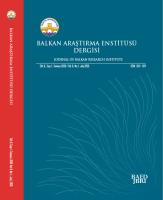BULGARİSTAN GÖÇMENLERİNİN ÇORUM’DA İSKÂNI (1938)
BULGARIAN IMMIGRANTS’ SETTLEMENT IN ÇORUM (1938)
Author(s): Hatice YıldırımSubject(s): Interwar Period (1920 - 1939), Migration Studies
Published by: Trakya Üniversitesi Balkan Araştırma Enstitüsü
Keywords: Bulgaria; Migration; Settlement; Çorum; Balkans;
Summary/Abstract: Bulgaria is the country where most Turks live among the Balkan countries. Acting with a nation-state approach, Bulgaria pursued a systematic policy to reduce the Turkish population. Turks living in Bulgaria were subjected to massacres and oppression at various periods in the historical process and forced to leave their native lands. The period of increased pressure on the Turkish population includes the 1930s, when fascist governments came to power in Bulgaria. In this period, it is seen that the Turkish people were deprived of basic rights in the fields of education, religion and culture, especially in the economy. In the face of the developments, between 1934 and 1938 a large number of Bulgarian Turks sought refuge in Turkey. During the same period, Turkey was subjected to an intense influx of migrants due to the realization of Turkish migrations from Romania, and had to identify new settlement areas such as Central Anatolia. Çorum is located at the crossing point between Central Anatolia and the Central Black Sea and was one of the new settlements designated for the settlement of migrants. In this study, it was tried to reveal various statistical data such as settlements, numbers, demographic characteristics and aid provided to the settlers of Bulgaria who settled in the region by examining the Immigration Registers of Çorum.
Journal: Balkan Araştırma Enstitüsü Dergisi -Trakya Üniversitesi
- Issue Year: 9/2020
- Issue No: 1
- Page Range: 199-229
- Page Count: 31
- Language: Turkish

